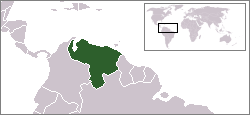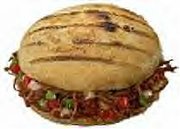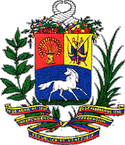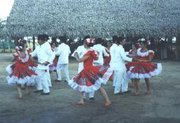Venezuela
|
|
The Bolivarian Republic of Venezuela (Spanish: República Bolivariana de Venezuela) is a country in northern South America. It borders the Caribbean Sea and the Atlantic Ocean to the north, Guyana to the east, Brazil to the south, and Colombia to the west. Off the Venezuelan coast are also found the Caribbean states of Aruba, the Netherlands Antilles and Trinidad and Tobago.
| |||||
| Motto: none | |||||
| National Anthem: Gloria al Bravo Pueblo | |||||

| |||||
| Capital | Caracas Template:Coor dm | ||||
| Largest city | Caracas | ||||
| Official language | Castilian (Spanish) | ||||
| Government | Federal republic Hugo Chávez | ||||
| Independence Declared Recognised | From Spain July 5, 1811 1821 | ||||
| Area • Total • Water (%) | 916,445 km² (32nd) 0.3 | ||||
| Population • 2004 est. • 2001 census • Density | 26.127.351 (45th) 23.54.210 27/km² (145th) | ||||
| GDP (PPP) • Total • Per capita | 2004 estimate $ 153,331 million (52nd) $ 5,801 (100th) | ||||
| Currency | Venezuelan bolívar (Bs.) (VEB)
| ||||
| Time zone | UTC -4 | ||||
| Internet TLD | .ve | ||||
| Calling code | +58
| ||||
| Note 1: The Bolivarian Republic of Venezuela has been the full official title of the state since the adoption of the 1999 constitution, when the state was renamed in honour of Simón Bolívar. | |||||
The name "Venezuela" is believed to have originated with the cartographer Amerigo Vespucci, when in 1499 led a naval exploration of the noroccidental coast (known today as the Gulf of Venezuela), along with Alonso de Ojeda. On reaching the Guajira Peninsula, the crew observed the stilt villages (palafitos) the natives built over the water. For Vespucci, this was a clear reminiscent of the city of Venice, and as a result, the region was named Venezuela, which means Little Venice.
| Contents |
History
Main article: History of Venezuela
Hw-bolivar.jpg
Venezuela was the site of one of the first permanent Spanish settlements in South America in 1522, and most of the territory eventually became part of the viceroyalty of New Granada. Parts of what is now eastern Venezuela became New Andalusia. After several unsuccessful uprisings, the country declared independence from Spain in 1811 under the leadership of its most famous son, Simón Bolívar.The revolutionary war was decided, however, in the famous battle of Carabobo in 1821 when the revolutionaries beat the Spaniards. Simon Bolivar led the armies of Venezuela and other countries to free and found what are now Colombia, Panama, Ecuador, Peru, and Bolivia. Another important revolutionary leader during the war was Antonio José de Sucre, who won many battles for Bolivar and was a candidate to become his natural succesor until he was murdered. Venezuela became, after the revolutionary war, along with Colombia and Ecuador part of the Republic of Gran Colombia (República de Gran Colombia) until 1830, when the country separated and became a sovereign republic.
Much of Venezuela's 19th and early 20th century history was characterized by political instability, political struggle, and dictatorial rule. Following the death of Juan Vicente Gómez in 1935 and the demise of caudillismo (authoritarian oligarchical rule), democratic struggles eventually forced the military to withdraw from direct involvement in national politics in 1958. Since that year, Venezuela has enjoyed an unbroken tradition of democratic civilian rule, though not without conflict.
In 1992, there was an attempt by rebellious entities within the Venezuelan military, led by Lieutenant Hugo Chávez, to remove two-time democratically elected president Carlos Andrés Pérez from power. The coup ultimately failed, and Chávez and his co-conspirators were jailed for treason. Pérez, on the other hand, was eventually impeached and convicted for corruption. The coup brought about the death of 80 civilians and 17 members of the armed forces. Chávez's role in resisting a president generally perceived as corrupt by the lower classes made him a prominent figure among them. Chávez was eventually released from jail in 1994 by Perez's elected successor, Rafael Caldera.
Chávez was elected president in 1998 with 56% of the vote as part of a new political party, the Movement for the Fifth Republic. His platform ("Bolivarian revolution") called for the signing of a new constitution, which was written by a Constituent Assembly and approved by referendum in 1999. Chávez was re-elected in 2000 under the new constitution with 59% of the vote. In November 2000, the National Assembly granted Chávez the right to rule by decree for one year, and in November 2001, Chávez made a set of 49 decrees, including large reforms in oil and agrarian policy. The Chávez presidency has continuously isolated the upper and middle classes because of his resentful speeches, his unorthodox economic, political and social policies, his alignment with communist Cuba and his distancing and constant bashing of the United States, Venezuela's biggest trading partner.
Chavez controls all branches of the government since his party has a majority in the National Assembly, and he has hand picked the judges of the Supreme Tribunal. He has been accused of jailing opposition leaders and establishing a near dictatorship.
In December 2001, the nation's largest business organizations and the petroleum workers' union organized a general strike. In 2002, the US-backed opposition staged an unsuccessful coup and briefly installed Pedro Carmona Estanga as president of Venezuela. Due to a subsequent, popular uprising, with support from the rank and file members of the military, Pedro Carmona was forced to resign. Diosdado Cabello, Vice President of Venezuela, became president as dictated by the constitution. Chávez was restored to the Presidency in 48 hours. A recall referendum was held on August 15, 2004, which Chávez won with approximately 58% of the vote. Leaders and supporters of the opposition accused Chavez of rigging the election, but failed to prove the accusation. The opposition claims were later silenced when the Organization of American States and the Carter Center certified the referendum. In 2004 plans for another coup were allegedly foiled.
Since then, Chávez's popularity in Venezuela and throughout Latin America, where two-thirds of the South American continent have elected leftist presidencies, has grown. As oil prices have soared in the wake of the second Iraqi war and booming Chinese demand, oil-rich Venezuela has had the opportunity to refuse loans and aid from the US, in its effort to distance Venezuela from the United States. The Bush Administration's influence in Caracas has plummeted, as president Hugo Chávez accuses the Bush administration of supporting the failed 2002 Venezuelan coup. A 35-year military agreement between the U.S. and Venezuela was unilaterally annulled by Venezuela on April 24, 2005. Under the Chávez administration, US narcotics programs in Venezuela have decreased, as they have little support from the Venezuelan government. Chávez's program has sought to decrease exclusive reliance on the United States and to diversify diplomatic and economic ties with governments throughout the world, such as Cuba, Brazil, Argentina, Uruguay, among many other Latin American countries, as well as China, Iran and India. His government has also consistently pursued closer ties to other countries opposed to the US, notably Fidel Castro's Cuba, as well as Libya, Iran and Saddam Hussein's Iraq.
Venezuela is member of the South American Community of Nations (SACN). (more)
See also: Discoverer of the Americas, List of Presidents of Venezuela
Politics
Main article: Politics of Venezuela
The Venezuelan president is elected by a plural vote, with direct and universal suffrage, and functions as both head of state and head of government. The term of office is six years, and a president may be re-elected to a single consecutive term. The president appoints the vice-president and decides the size and composition of the cabinet and makes appointments to it with the involvement of the legislature. The president can ask the legislature to reconsider portions of laws he finds objectionable, but a simple parliamentary majority can override these objections.
The unicameral Venezuelan parliament is the National Assembly or Asamblea Nacional. Its 165 deputies, of which three are reserved for indigenous peoples, serve five-year terms and may be re-elected for a maximum of two additional terms. They are elected by popular vote through a combination of party lists and single member constituencies. The highest judicial body is the Supreme Tribunal of Justice or Tribunal Supremo de Justicia, whose magistrates are elected by parliament for a single 12-year term. The Consejo Nacional Electoral is in charge of electoral processes; it is formed by five main directors elected by the National Assembly. (more)
Political Division
Main article: Political Division of Venezuela
Venezuela is subdivided into 23 states (estados), one capital district (distrito capital) and the federal dependencys (dependencias federales):
EstadosVenezuela02.JPG
Geography
Main article: Geography of Venezuela
Venezuela is home to a wide variety of landscapes, such as the northeasternmost extensions of the Andes mountains in the northwest and along the northern Caribbean coast, of which the highest point is the Pico Bolívar at 5,007 m.
Angel_falls.jpg
Also found in the northwest are the lowlands around Lake Maracaibo and the Gulf of Venezuela. The centre of the country is characterised by extensive plains known as the llanos that stretch from the Colombian border to the river delta of the Orinoco east. To the south are found the dissected Guiana Highlands, home to Angel Falls, the world's highest waterfall.
The local climate is tropical and generally hot and humid, though more moderate in the highlands. The capital, Caracas is also the country's largest city. Other major cities include Maracaibo, Barquisimeto, Valencia, Maracay, and Ciudad Guayana. (more)
Demographics
Main article: Demographics of Venezuela
The Venezuelan people comprise a rich combination of heritages. The historically present Amerindians, Spanish colonists and Africans were joined by Italians, Portuguese, Arabs, Germans, and others from neighbouring countries in South America during waves of immigration in the 20th century. About 85% of the population live in urban areas in the northern portion of the country. While almost half of Venezuela's land area lies south of the Orinoco river, this region contains only 5% of the population.
The national and official language is Spanish, but numerous indigenous languages also exist (Guajiro, Pemon, Warao, etc), as do dialects introduced by immigrants. Nominally 96% of the population is Roman Catholic; other denominations, primarily Protestants, make up the remainder, as well as a Jewish community of about 30,000 (http://www.worldjewishcongress.org/communities/world/latinamerica/venezuela.cfm). (more)
Economy
RefineríaCardón.jpg
Main article: Economy of Venezuela.
The petroleum sector dominates the economy, accounting for roughly a third of GDP, around 80% of export earnings, and more than half of government operating revenues. The sector operates through the government-owned Petroleos de Venezuela, which among other things owns the US Citgo distributor, which has 14,000 service stations in the US.
See also: Companies of Venezuela
Military
Main article: Military of Venezuela
(Article to be added)
Culture
DiablosDanzantesYare.jpg
Main article: Culture of Venezuela; see also: Music of Venezuela
(Article to be added) (Main article to be developed)
List of Venezuelan Holidays
Famous Venezuelans
Gastronomy

Below is a list of popular and typical Venezuelan dishes and snacks:
Main Dishes
- Arepa
- Hallaca
- Pabellón criollo (Creole pabillion)
- Cachapa (Maize tortilla).
- Chivo en coco (Goat meat with coconut).
- Empanada
- Mandoca
- Pisillo de chigüire
- Asado negro
- Mondongo (Tripe).
- Bollo pelón
- Chicharrón
- Pisca Andina
- Perico
Typical Snacks
- Arroz con coco (Rice with coconut).
- Arepa
- Tequeño
- Tostón
Typical Candies
- Majarete
- Bienmesabe
- Dulce de lechoza
- Dulce de leche (A solid version made in the city of Coro)
Beverages
National Symbols
Venezuela's national symbols include the Flag, the Coat of Arms, and the National Anthem. Other elements relative to the typical flora and fauna of the territory are remarkable. The governments through history have officially declared these as national symbols:

National Flower
- The orchid (Cattleya mossiae)
This kind of orchid is also known as Flor de Mayo (May Flower). Was first discovered in the northern land in 1839. Was given the status of National Flower on May 23, 1951.
Aragüaney.JPG
National Tree
- The aragüaney (Tabebuia chrysantha)
Called aravanei by the caribes, it can be found mostly in regions with template weather. It can reach a height between 6 and 12 m. The aragüaney flourishes within the period following a rainy season, mostly on the first months of the year. Rómulo Gallegos referred to these months as "La primavera de oro de los aragüaneyes" (the golden spring of the aragüaneyes). Declared National Tree on May 29, 1945.
Turpial.JPG
National Bird
- The turpial (Icterus icterus)
Fully coloured with yellow-orange tones except in the head an the wings, which are black with a few tones in white; also has a blue spot surrounding the eyes. It can be found in woods, the llanos, at the shores of jungles, and in northern and southern Orinoco. The turpial is fairly appreciated due to its singing and was declared the National Bird on May 23, 1958.
See also
- Media of Venezuela
- National parks of Venezuela
- Transportation in Venezuela
- OPEC
- South American Community of Nations
- Miss Venezuela
External Links
Template:Commons Template:Wikisource
Government Sites
- Gobierno en Línea (http://www.gobiernoenlinea.ve) - Official governmental portal (in Spanish)
- Presidencia de la República de Venezuela (http://www.venezuela.gov.ve) - Official Presidential Site (in Spanish)
- Asamblea Nacional (http://www.asambleanacional.gov.ve) - Official Parliamentary Site (in Spanish)
Media and Communications
- Globovisión (http://www.globovision.com) - Venezuelan News Channel
- Unión Radio (http://www.unionradio.com.ve)
- Diario El Universal (http://www.eud.com)
- Diario El Nacional (http://www.el-nacional.com)
- Diario Tal Cual (http://www.talcualdigital.com)
- VHeadline.com (http://www.vheadline.com/main.asp)
- Venezuelanalysis.com (http://www.venezuelanalysis.com/)
- Noticias de Venezuela (http://notiven.com) (in Spanish and English)
- Venezuelatoday (http://www.venezuelatoday.net/) One Stop Source for Latest News and Information
Culture, Images and Tourism
- Efemérides Venezolanas (http://www.efemeridesvenezolanas.com) (in Spanish).
- Venezuela in Photographs (http://www.marceloanelli.com/xoom/) (in Spanish).
- Venezuela Tuya (Venezuela Yours - Le Venezuela Votre): A country to love (http://www.venezuelatuya.com) - Venezuelan tourist portal.
- Discover Venezuela (http://www.discovervenezuela.com) - for more information and images.
- Venezuelan Picture Gallery (http://www.turpial.org) Pictures of cities, landscapes, animals and plants.
Miscellaneous
- Government of Ramón J. Velásquez (http://www.geocities.com/otalvora/libros/pazramo/indexpax.htm)
- The Letter is back (http://theletterisback.blogspot.com/)
| Countries in South America |
|---|
| Argentina | Bolivia | Brazil | Chile | Colombia | Ecuador | Guyana | Panama | Paraguay | Peru | Suriname | Trinidad and Tobago | Uruguay | Venezuela |
| Dependencies: Falkland Islands | French Guiana |
ar:فنزويلا ca:Veneçuela cs:Venezuela da:Venezuela de:Venezuela et:Venezuela es:Venezuela eo:Venezuelo fr:Venezuela ga:Veiniséala gl:Venezuela ko:베네수엘라 id:Venezuela it:Venezuela he:ונצואלה la:Venetiola lv:Venecuēla lt:Venesuela ms:Venezuela zh-min-nan:Venezuela nl:Venezuela nds:Venezuela ja:ベネズエラ no:Venezuela pl:Wenezuela pt:Venezuela ru:Венесуэла sa:वेनेज्वेला simple:Venezuela sk:Venezuela sl:Venezuela sr:Венецуела sq:Venecuela fi:Venezuela sv:Venezuela tr:Venezuela uk:Венесуела yi:װענעזװעלע zh:委內瑞拉





